Killing Bosnia's Ghosts: Fighting to Remember the Balkan War Genocide
On the day that Bosnian Serb authorities finally went to remove the word "genocide" from the memorial plaque commemorating the mass killing of Muslims in Visegrad in 1992, Bakira Hasecic woke up early, along with a few other women.
She had stayed overnight in the house she still owns in the eastern Bosnian town, although she now lives in Sarajevo. The morning was brisk but not particularly cold, a rarity in those January days.
Their intention was to stop what they saw as desecration of the memorial. They were too late.
When she arrived at the Straziste Muslim cemetery, 150 police in riot gear were lined up along the road, some shaking off the crisp mountain air, others laughing at her.
Visibly distressed and with her legs shaking, Bakira hurried to cover the gravestones bearing the names of Serb war criminals Milan and Sredoje Lukic and T-shirts printed with the names of those who died.
A local woman discreetly wrote "genocide" back on the memorial in lipstick. The inscription, once chiselled into the stone, had been removed by a workman with an angle grinder.
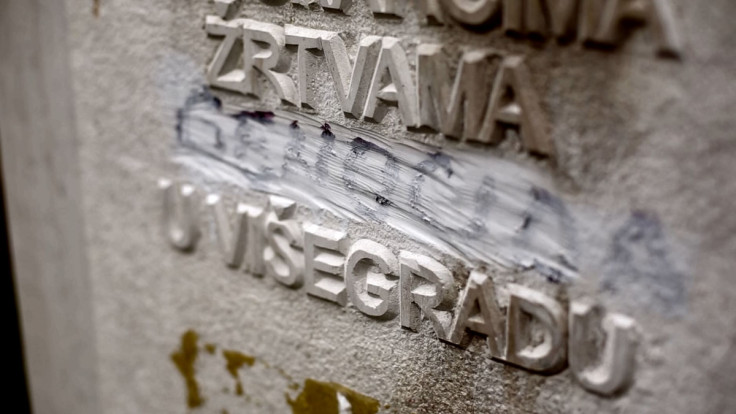
"They are bothered by the word 'genocide'. They cannot face the truth," Bakira, a survivor of the Balkan war who was raped multiple times by Serb paramilitaries led by Milan Lukic, told IBTimes UK.
After 20 years, a bitter struggle over collective memory still haunts this sleepy town in Republica Srpska, the ethnically cleansed enclave carved out in the 1992-95 conflict.
What Bosnian Serbs did to Muslims in 1992 they are still doing today, minimising and concealing those crimes.
In August 1992, while the capital Sarajevo was under siege, Visegrad, strategically located on the majestic River Drina between Bosnia and Serbia, was taken over by Serb forces and purged of its majority Muslim population in a campaign of terror carried out by Lukic and his cousin Sredoje.
Muslim men were rounded up and murdered. Hundreds of women were detained and mass-raped at the spa, the infamous Vilina Vlas. Women, children and elderly people were locked in houses and burnt to death.
A widespread culture of denial in Visegrad is now being encouraged by Serb nationalists who want separatism from Bosnia.
"What Bosnian Serbs did to Muslims in 1992 they are still doing today, minimising and concealing those crimes," says Bilal Memisevic, president of the local Muslim community.
Barimo
Barimo is a hamlet nestled in the folds of the hills, at 15-minute car ride from Visegrad, along the emerald waters of the Drina.
Only 78 Bosnian Muslims lived there before the war, in modest houses overlooking green meadows and plum orchards on the riverbanks. In the early hours of August 1992, Serb forces entered the village for a killing spree. Twenty-six people - mostly women and children - were massacred.
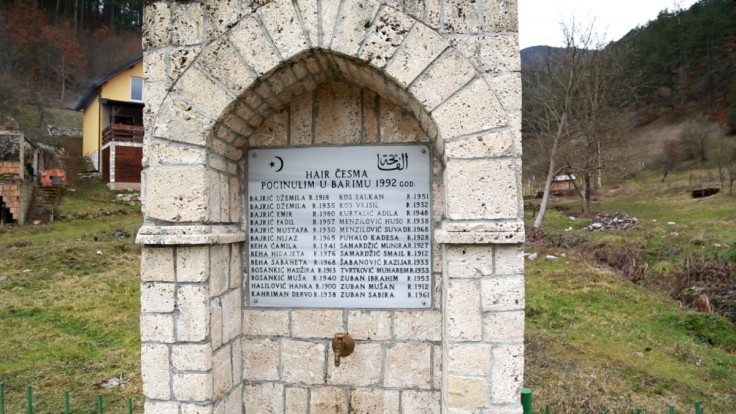
Resident Suljo Fejzic was sheltering with his family in a village above Barimo. He sneaked into the village that morning, finding his way among the bushes and the mountain pines.
"When we entered the village all the houses were burning. Everything was burning," he recounts.
"At the bank of the river they executed 12 people and put the bodies in a pile, at the place where the stream joins the river Drina. Later when we got back to the village, we came across people who had been killed trying to escape, we found people who had been shot in the head while lying on the ground".
The river
The oldest victim was Hanka Halilovich, who was born in 1900, and the youngest was 12-year-old Fadila Bajric. As late as 2004, Fejzic and other villagers kept finding bodies in half-burnt houses, the victims executed with their faces in the dirt.
"But the largest mass grave is the river," he tells IBTimes UK, pointing to where a silent stream meets the Drina.
Bodies of lifeless Muslims were floating on the Drina like ants. My house was near the bank of Drina, which was filled with blood.
The river and the grand 16th-century bridge built on 11 arches that decorates Visegrad were made famous by the 1945 masterpiece by Nobel prize-winning writer Ivo Andric in The Bridge on the Drina. The novel captures the construction of the Mehmed Paša Sokolović Bridge and the uneasy relationship between the cultures of Christian Europe and the Islamic Ottoman Empire, a relationship that still exists albeit in a different form.
A Unesco World Heritage Site, the bridge became during the war the nightmarish bloodsoaked centre of the town, a place where Bosnian Muslim men, women and children were slaughtered by Bosnian Serb paramilitary forces and thrown into the river. Lukic troops used to grab any piece of glass they could find and slit the throat of innocent civilians. One victim was found with a screwdriver in their neck.
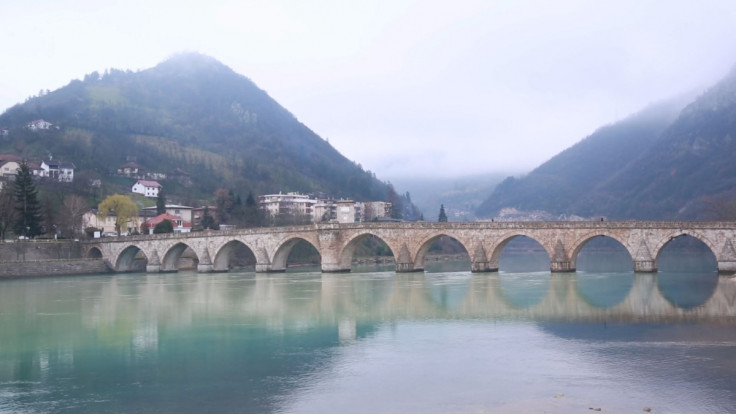
"Bodies of lifeless Muslims were floating on the Drina like ants. My house was near the bank of Drina, which was filled with blood," says Bakira Hasecic.
This immense, underwater graveyard is the perfect metaphor for Visegrad, where the past is "unforgiven, unforgotten, unresolved" as correspondent Alec Russell put it.
Before the war, 63% of the town's 25,000 people were Bosnian Muslims. Despite the Dayton peace agreement calling for the Bosnian Muslims to be able to return to their homes, only around 5% have come back.
"Only a few have returned to the town itself. Most have gone back to the surrounding villages where they can be with other returnees, earning a living from livestock and agriculture," says Jasna Causevic, of the German group Society for Threatened Peoples.
Sometimes, though, the past emerges in full force from the swamps of history.
When in 2010 the water levels of the reservoir behind the Bajna Bast hydroeletric dam - called Lake Perucac - further downstream were lowered the remains of more than 160 civilian victims from Visegrad were found in a 50km-stretch of lake bed.
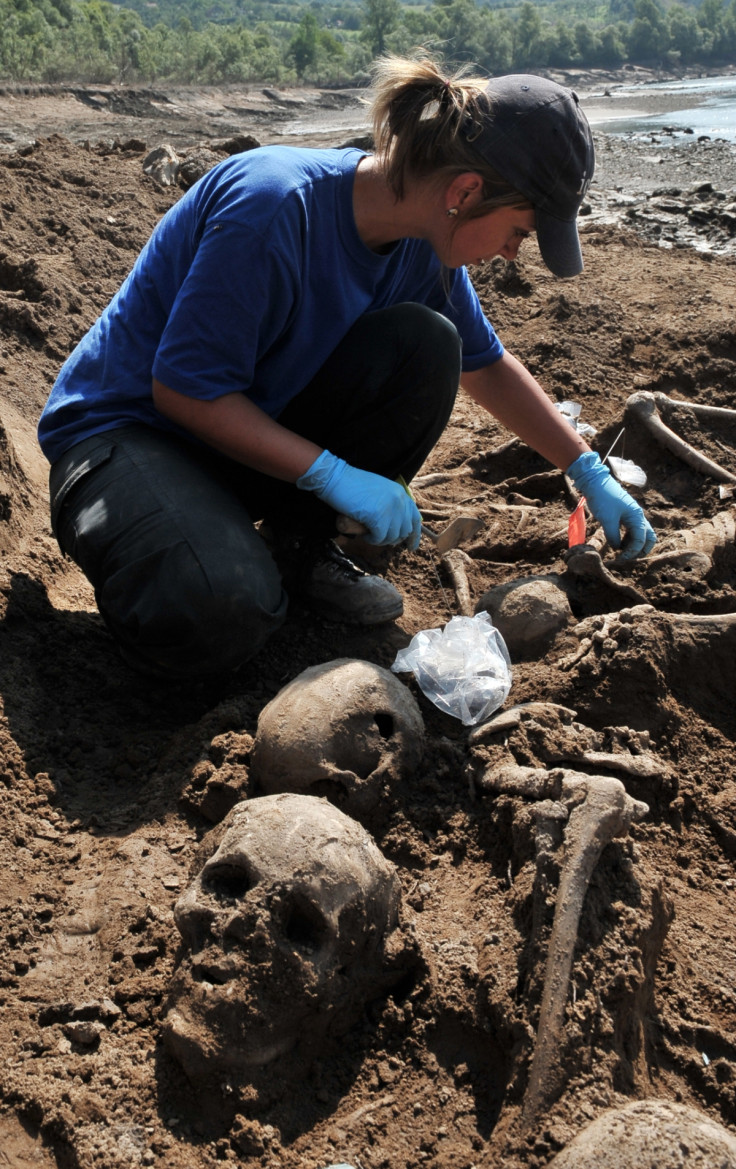
At least 3,000 Muslims were massacred in the eastern Bosnian town. But to many Serbs the 1992 attack was a preventive strike whose aim was to avoid a repetition of past slavery under the Ottomans.
Muslims used to prosper under the Ottoman Empire but the Serbs were serfs, uneducated and exploited for manual labour.
President Slobodan Milosevic's idea of a "Greater Serbia" appealed to many of his local countrymen and laid the foundation for the massacre that followed.
At the start of the 1992 war, short-term actions of resistance by Bosniaks provided the perfect excuse for an alternative Serbian narrative of the war. A small group of Bosniaks took control of the Bajna Basta dam on Lake Perucac and threatened to open it, threatening massive flooding downstream and sabotaging the electricity supply to parts of Serbia.
Adem Omeragic house
The battle for memory and the power to write history are entangled in the bare bricks of another key building of the town. On Pionirska Street, the Serb administration wants to demolish Adem Omeragic's house, where one of the worst atrocities of the war was committed by Milan Lukic.
Such was its ferocity that it was singled out by the International Criminal Tribunal for the former Yugoslavia.
At least 59 Muslim women, children and elderly people were locked in the house and burned alive after they had been rounded up, raped, sexually abused and robbed. Some witnesses put the death toll higher.
"Some of them who survived sexual abuse were killed in one of the rooms in the basement. There were the remains of more than 70 of them, 49 women alone and about 20 children after the burning and devastation," says Bakira Hasecic.
With her Association of Women Victims of War, Hasecic rebuilt the house in two weeks and says she has been given permission by the owner to turn it into a memorial.
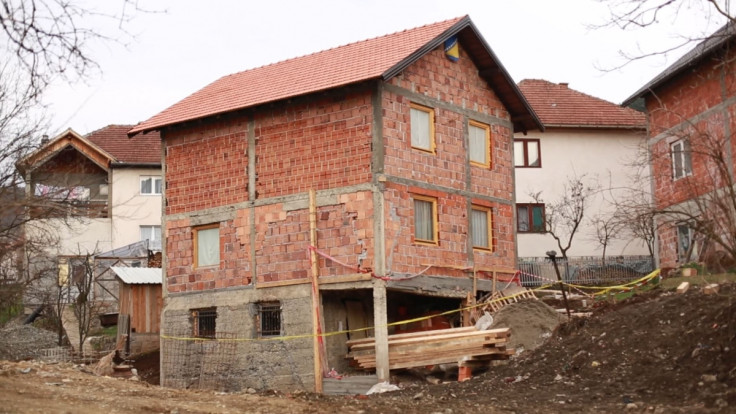
"We reconstructed the house from the same material, exactly the way it used to be before, identical to how it was before it was burned with people inside," she says.
"However, I encountered resistance in the municipality of Visegrad. What I had to suffer on those days when we started rebuilding the house in some moments was more difficult than 1992. Every day, for about 12 days when we began to work behind the house, some 15 to 20 police officers would come in, obstruct us, and put pressure on us."
Serbs are not allowed to make any kind of memorial in Sarajevo, where I lived for some 18 years
The municipality claims that according to the town's planning map, a road was due to be built through the place where the house stood. The mayor of Visegrad, Slavisa Miskovic, confirms that "manipulacija", political manipulation, is playing a part.
"No one denies that a crime happened there, but what is happening now is to do with the building of the road. I didn't come up with this proposal, these proposals were inherited from the previous administration," the mayor says.
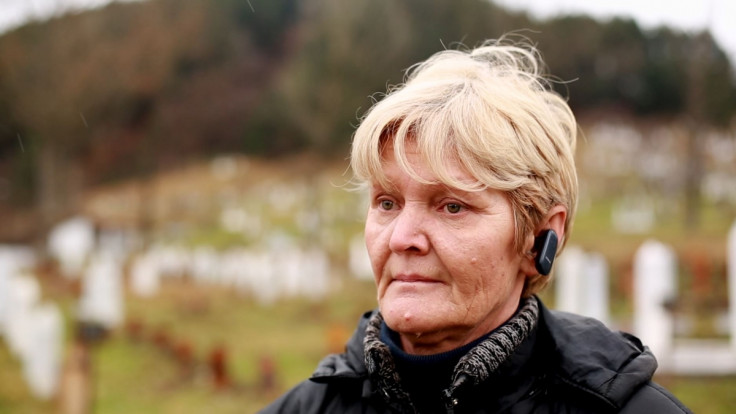
In the gentle wrinkles of her face, Bakira still shows the psychological scars of sexual violence and abuse.In 1992, she was forced to watch as a group of Serbs that included her next-door neighbour raped her 18-year-old daughter.
The girl's head was cracked with a rifle butt but she managed to survive. Her sister, however, was raped and killed by Lukic troops in the infamous rape camps of Vilina Vlas spa. Bakira herself was raped countless times in her home and at the local police station.
"I was a happy woman, I worked in the municipality, 90% of my friends were Serbs and they killed everything that was beautiful in me," she says.
Erasing the past
The Serb Democratic Party (SDS), which has run Visegrad municipality since October 2012, denies that there has been any "disturbance" against Muslim returnees in the town and seizes on legal jargon to erase memories of the 1992 genocide.
Slavisa Miskovic, the mayor, is an outspoken and animated man who at first sight bears no resemblance to the perpetrators of the war. He talks of respect for all victims of war, regardless of nationality and ethnic origin, and cautiously admits that not enough has been done for Bosniak returnees in Bosnia and Herzegovina.
But when he turns to the disputed Stražište memorial commemorating the Bosniak genocide, the alternative reality of the war re-emerges in full force.
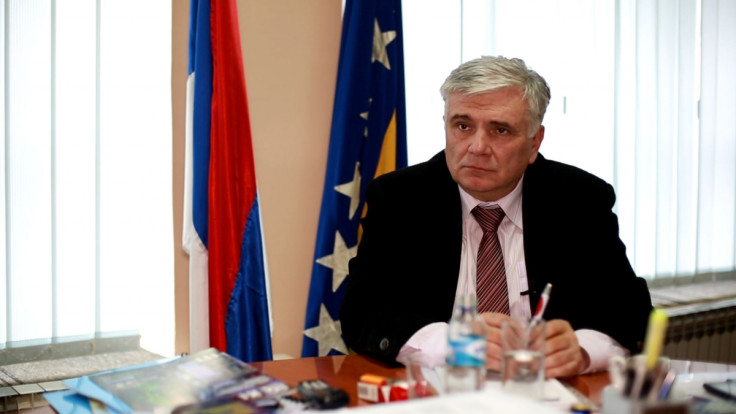
He says the "genocide" inscription was removed from the memorial because there was no planning permission granted and because the word itself was dangerously emotive and had no legal basis.
"Serbs are not allowed to make any kind of memorial in Sarajevo, where I lived for some 18 years," he says.
"Regarding the disputed monument on Stražište there are no arguments or legal basis for the use of such a word [genocide] and it causes destabilisation in the municipality of Visegrad," Miskovic adds.
Those responsible for the massacres, Milan and Sredoje Lukic, are serving respectively a life sentence in Estonia and 27 years in Norway. But the mayor argues that there have been no convictions at the International Tribunal for the Former Yugoslavia at The Hague for genocide.
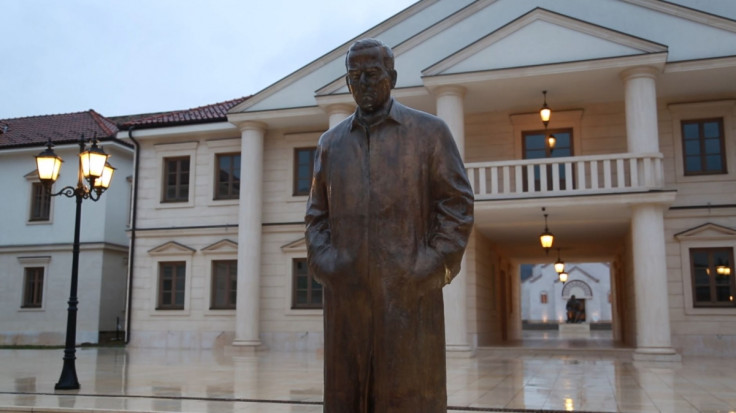
He says the activists demanding recognition of what happened to the Muslim community in those dark days are manipulating that community. His administration, he maintains, is adhering to all legal procedures and prefers to look to the future.
He proudly displays an architectural plan of the controversial Andricgrad theme park, a "town within a town" dedicated to literature that will be inaugurated in June with the aim of providing jobs to Bosniaks and Serbs alike and boost tourism.
This geometric reverie, a sort of half-deserted pastiche of Bosnia's histories and architectural styles, has been conceived and will be built by two-time Cannes Film Festival winner Emir Kusturica, a Serbian. It is being raised on the site of a former sports centre that was used as a detention camp during the 1992-95 war.
The thing that prevents peace from being stabilised is those who seek to be revisionist towards history.
Bosnian Serbs are willing to accept that atrocities were committed during the war but use explanations, excuses and diversions. The crimes, they say, were purely the actions of a psychopath such as Milan Lukic.
Recognising that genocide took place in Republika Sprska – that ethnically cleansed enclave hacked off from Bosnia, which is pushing for annexation with Serbia – would mean acknowledging that their state existed as a result of mass murder.
Paddy Ashdown served as international community's high representative for Bosnia and Herzegovina from 2002 to 2006 and was highly praised for his proactive efforts to bring Bosnian Serb war criminals to justice and strengthen the central state institutions.
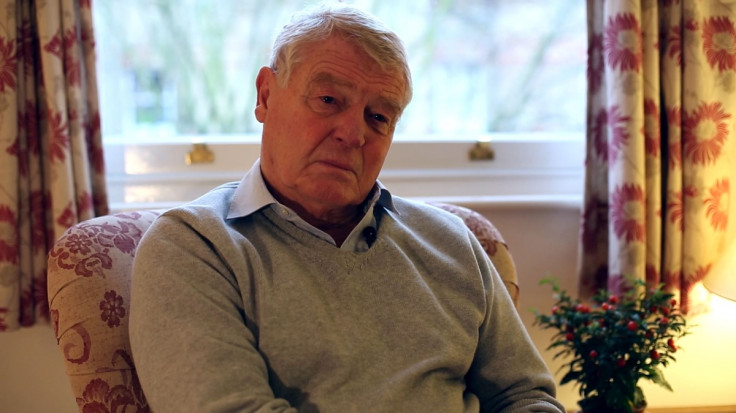
He is highly critical of the secessionist policies of Republika Srpska and maintains that there was a positive verdict on the genocide charges.
In an interview with IBTimes UK, he says: "I know that the thing that prevents peace from being stabilised is those who seek to be revisionist towards history, to pretend that Srebrenica never happened. If you cannot come to terms with your past, you cannot build your future."
Visegrad may prove to be the exception.
© Copyright IBTimes 2025. All rights reserved.





















